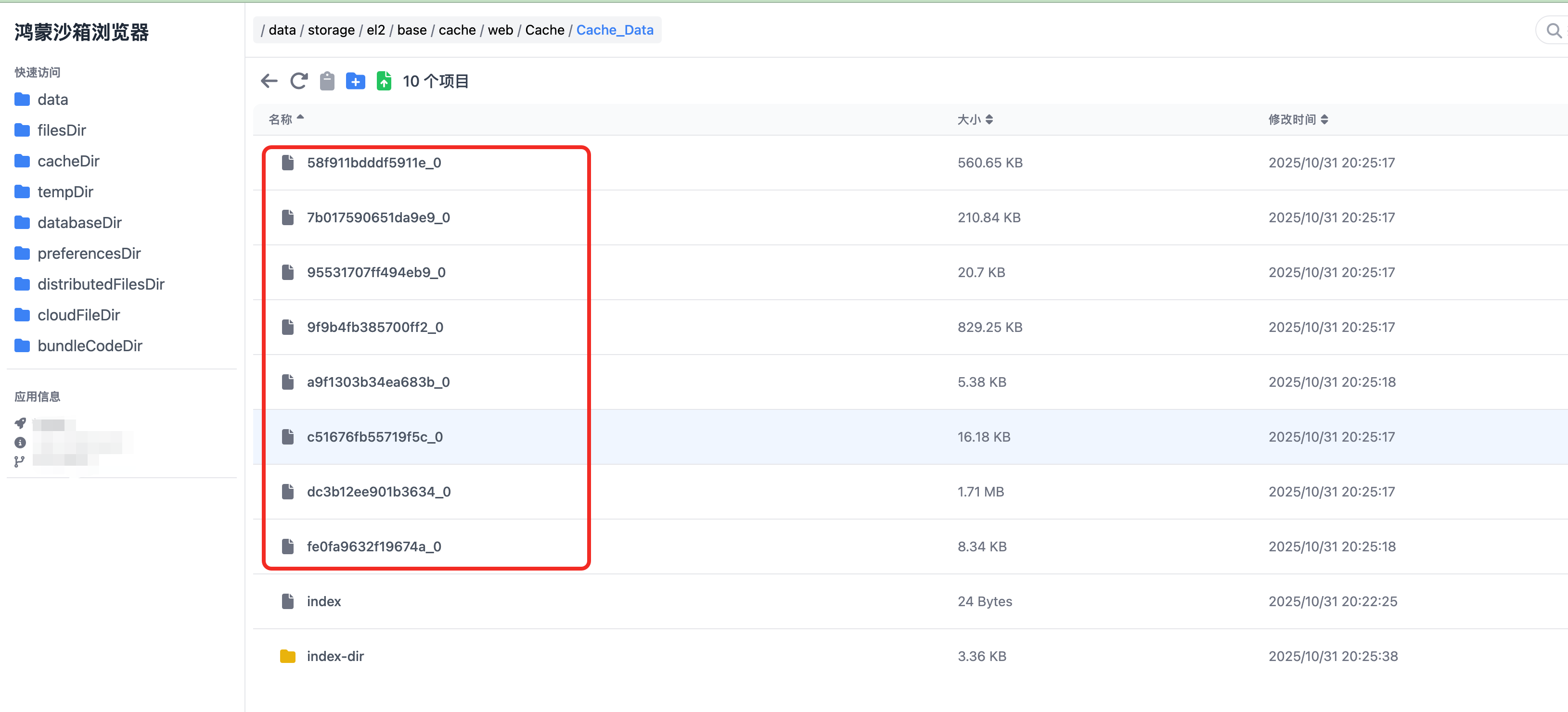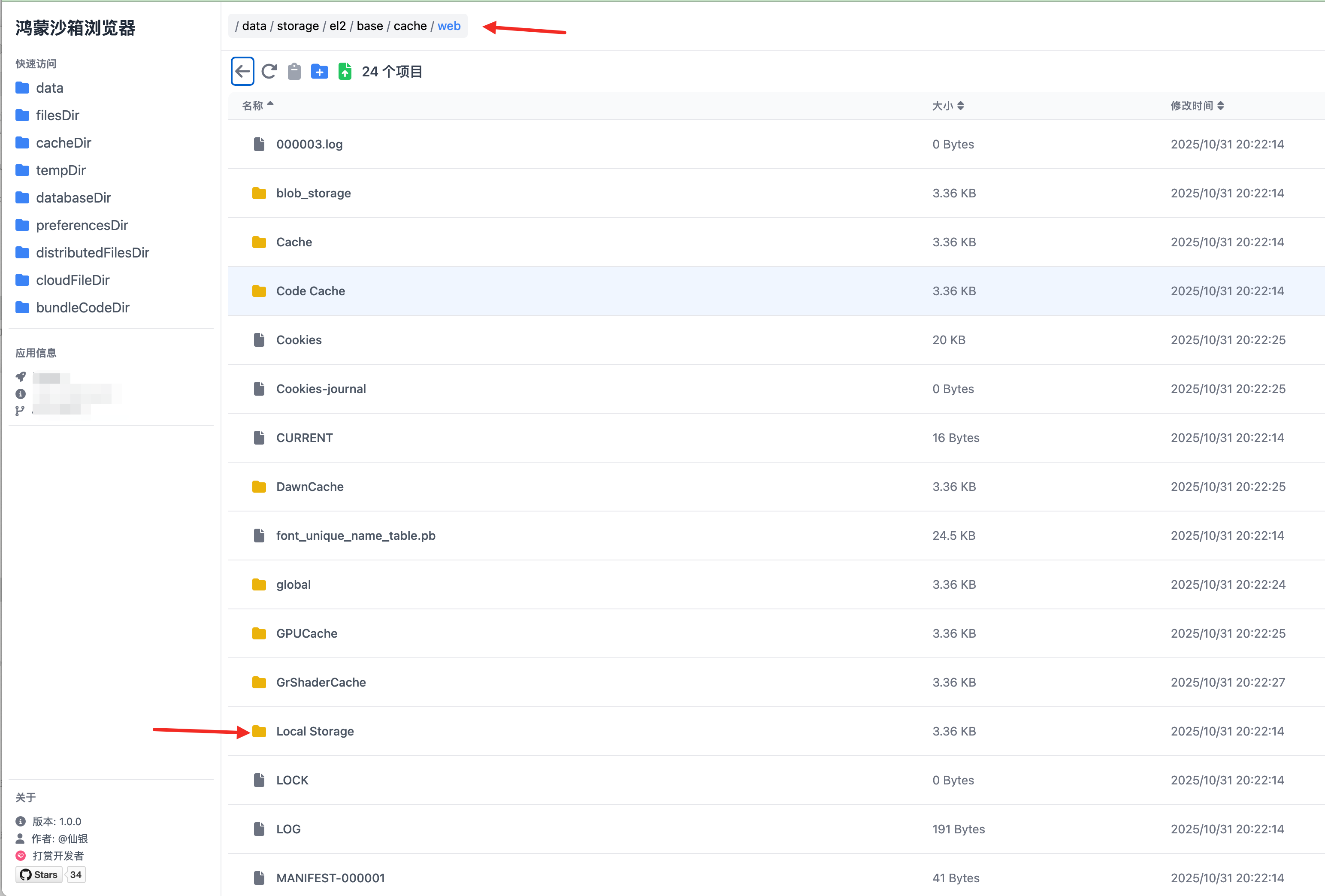HarmonyOS鸿蒙Next中Web组件removeCache与removeAllCache有什么区别,删除的资源优化不同?
HarmonyOS鸿蒙Next中Web组件removeCache与removeAllCache有什么区别,删除的资源优化不同? Web组件removeCache与removeAllCache有什么区别,删除的资源优化不同?可以删除localStorage吗?
removeCache与removeAllCache的区别
1. removeCache(实例方法)
- 所属类:
WebviewController - 作用范围:清除当前WebviewController关联的Web组件的资源缓存
- 调用方式:
this.controller.removeCache(clearRom) - 参数说明:
clearRom: boolean- true时同时清除ROM和RAM中的缓存,false时只清除RAM中的缓存
- 特点:需要WebviewController与Web组件绑定后才能使用
2. removeAllCache(静态方法)
- 所属类:
WebviewController(静态方法) - 作用范围:清除同一应用中所有Webview的缓存文件
- 调用方式:
webview.WebviewController.removeAllCache(clearRom) - 参数说明:
clearRom: boolean- true时同时清除ROM和RAM中的缓存,false时只清除RAM中的缓存
- 特点:影响范围更大,会清理应用内所有Web组件的缓存
详细可以参考 如何清除Web组件缓存-行业常见问题-实用工具类行业实践
删除的资源类型
两个方法清除的都是Web组件的资源缓存文件,包括:
- 网页资源文件缓存
- 图片等静态资源缓存
- 不包含localStorage数据
更多关于HarmonyOS鸿蒙Next中Web组件removeCache与removeAllCache有什么区别,删除的资源优化不同?的实战系列教程也可以访问 https://www.itying.com/category-93-b0.html
使用removeCache需要实例化webview,且webview需绑定controller完成后,才能调用removeCache()方法,觉得使用起来麻烦。
API 18以后,新增了removeAllCache这个静态方法,可直接调用。 文档给出的删除路径为:
data/app/el2/100/base/<applicationPackageName>/cache/web/
这是一个物理路径,会把web目录下的文件都删除。那么Local Storage应该是可以删除的。
通过鸿蒙沙箱浏览器 验证后发现 removeCache 只是删除了下图中红框的部分资源
data/storage/el2/base/cache/web/Cache/Cache_Data/

而 Local Storage 从目录来看位于 /data/storage/el2/base/cache/web/Local Storage。
这么看来 removeCache 是无法删除 local Storage的。

目前手里的设备没有升到API18,暂时没有验证removeAllCache方法的效果。
不过,我们之前对于删除沙箱的web缓存,采用下面的方法,希望对你有帮助:
async clearWebCache() {
const context = this.getUIContext().getHostContext()
const moduleContext = await application.createModuleContext(context, 'entry');
const path = moduleContext.cacheDir + '/web'
const isDirectory = fileIo.statSync(path).isDirectory();
if (isDirectory) {
fileIo.rmdirSync(path)
}
}
【问题背景】
- Web 组件提供的
removeCache与removeAllCache两个接口在功能上有何区别,尤其在删除资源的范围、优化逻辑上是否存在差异; - 这两个接口能否直接删除
localStorage数据。
【解答思路】
- “先区分两个缓存清除接口的差异,再说明
localStorage的处理机制” 展开,具体逻辑如下:
- 先明确
removeCache与removeAllCache的核心差异(从 “影响范围” 和 “使用条件” 切入) - 两者虽均用于清除 Web 组件缓存,但因设计定位不同,在作用边界、调用前提、删除资源路径上存在显著区别,需结合开发场景选择:
- 从 “作用范围” 看:
removeCache是 “实例级” 接口,仅作用于当前创建的WebviewController实例,清除的是该实例加载的资源缓存(对应路径为应用内data/storage/el2/base/cache/web/Cache目录);而removeAllCache是 “应用级” 静态接口,作用于整个应用的 Web 组件缓存,清除的是应用沙盒内所有 Web 缓存文件(对应路径为data/storage/el2/base/cache/web目录)。 - 从 “调用条件” 看:
removeCache需依赖已初始化的WebviewController实例(即 Web 组件先创建后才能调用);removeAllCache无需初始化 Web 组件,且仅在 API18 及以上版本支持,直接通过webview.WebviewController静态调用即可。 - 从 “参数与效果” 看:两者均接收
boolean类型参数,true代表同时清除 ROM(本地持久化存储)和 RAM(内存临时存储)中的缓存,false仅清除 RAM 缓存;但因作用范围不同,removeCache仅影响当前实例的缓存状态,removeAllCache会清空整个应用的 Web 缓存,需谨慎使用(避免误删其他 Web 实例的必要缓存)。 - 从 “代码实现” 看:
removeCache通过this.controller.removeCache(...)(实例方法)调用,removeAllCache通过webview.WebviewController.removeAllCache(...)(静态方法)调用,需注意导入包和错误捕获逻辑的一致性(均需处理BusinessError异常,打印错误码和信息)。
2. localStorage的删除逻辑(明确 “不直接处理” 的核心结论)
removeCache与removeAllCache的设计目标是清除 Web 组件的资源缓存(如页面静态资源、请求缓存等),不包含对localStorage的直接删除能力。localStorage的删除依赖 JavaScript 垃圾回收(GC)机制:当LocalStorage实例的所有引用(如页面关闭、实例对象销毁)被完全释放后,GC 会自动识别并回收该实例的内存与数据,无需通过上述两个缓存接口主动处理。
补充说明:
Cache
使用cacheMode()配置页面资源的缓存模式,Web组件为开发者提供四种缓存模式,分别为:
- Default:优先使用未过期的缓存。如果缓存不存在,则从网络获取。
- None:加载资源使用缓存。如果缓存中无该资源,则从网络中获取。
- Online:加载资源不使用缓存。全部从网络中获取。
- Only:只从缓存中加载资源。
Dom Storage
Dom Storage包含了Session Storage和Local Storage两类。Session Storage为临时数据,其存储与释放跟随会话生命周期;Local Storage为持久化数据,保存在应用目录下。两者的数据均通过Key-Value的形式存储,在访问需要客户端存储的页面时使用
您好,removeCache作用范围为单个 Web 组件实例,
使用实例接口removeCache,清除应用中data/storage/el2/base/cache/web/Cache目录下所有的资源缓存文件,需要创建WebviewController实例对象之后调用。removeCache() 执行后仅删除当前WebviewController实例加载的资源。
import { webview } from '@kit.ArkWeb';
import { BusinessError } from '@kit.BasicServicesKit';
@Entry
@Component
struct WebComponent {
@State mode: CacheMode = CacheMode.None;
controller: webview.WebviewController = new webview.WebviewController();
build() {
Column() {
Button('removeCache')
.onClick(() => {
try {
// 设置为true时同时清除rom和ram中的缓存,设置为false时只清除ram中的缓存
this.controller.removeCache(true);
} catch (error) {
console.error(`ErrorCode: ${(error as BusinessError).code}, Message: ${(error as BusinessError).message}`);
}
})
Web({ src: 'www.example.com', controller: this.controller })
.cacheMode(this.mode)
}
}
}
而removeAllCache的作用范围是全局应用级,
API18及以上版本可以使用静态接口removeAllCache,清除应用中“data/storage/el2/base/cache/web”目录中所有的缓存文件,Web组件未初始化时也可调用。removeAllCache() 执行后会删除应用沙盒中所有缓存文件。
// xxx.ets
import { webview } from '@kit.ArkWeb';
import { BusinessError } from '@kit.BasicServicesKit';
@Entry
@Component
struct WebComponent {
controller: webview.WebviewController = new webview.WebviewController();
build() {
Column() {
Button('removeAllCache')
.onClick(() => {
try {
webview.WebviewController.removeAllCache(true);
} catch (error) {
console.error(`ErrorCode: ${(error as BusinessError).code}, Message: ${(error as BusinessError).message}`);
}
})
Web({ src: 'www.example.com', controller: this.controller })
}
}
}
整个LocalStorage实例在其所有引用释放后 垃圾回收机制会自动删除。
removeCache用于删除Web组件中指定URL的缓存资源,包括内存缓存和磁盘缓存。removeAllCache则清除Web组件的全部缓存数据,包括所有URL的缓存资源、Cookie、本地存储等。两者删除范围不同,removeCache针对特定URL,removeAllCache清理全部缓存。资源优化方面,removeCache适用于精确清理特定页面缓存,removeAllCache用于整体重置Web组件的缓存状态。
在HarmonyOS Next的Web组件中,removeCache和removeAllCache方法的主要区别在于删除范围:
removeCache:删除指定URL的缓存资源,适用于清理特定页面的缓存数据,保留其他页面缓存,优化资源占用。
removeAllCache:清除Web组件所有已加载页面的缓存,适用于全局清理,释放全部缓存资源。
两者均针对网络缓存(如HTML、CSS、JS文件等),无法删除localStorage。localStorage属于浏览器API存储的持久化数据,需通过Web标准接口(如localStorage.clear())在页面内操作。






